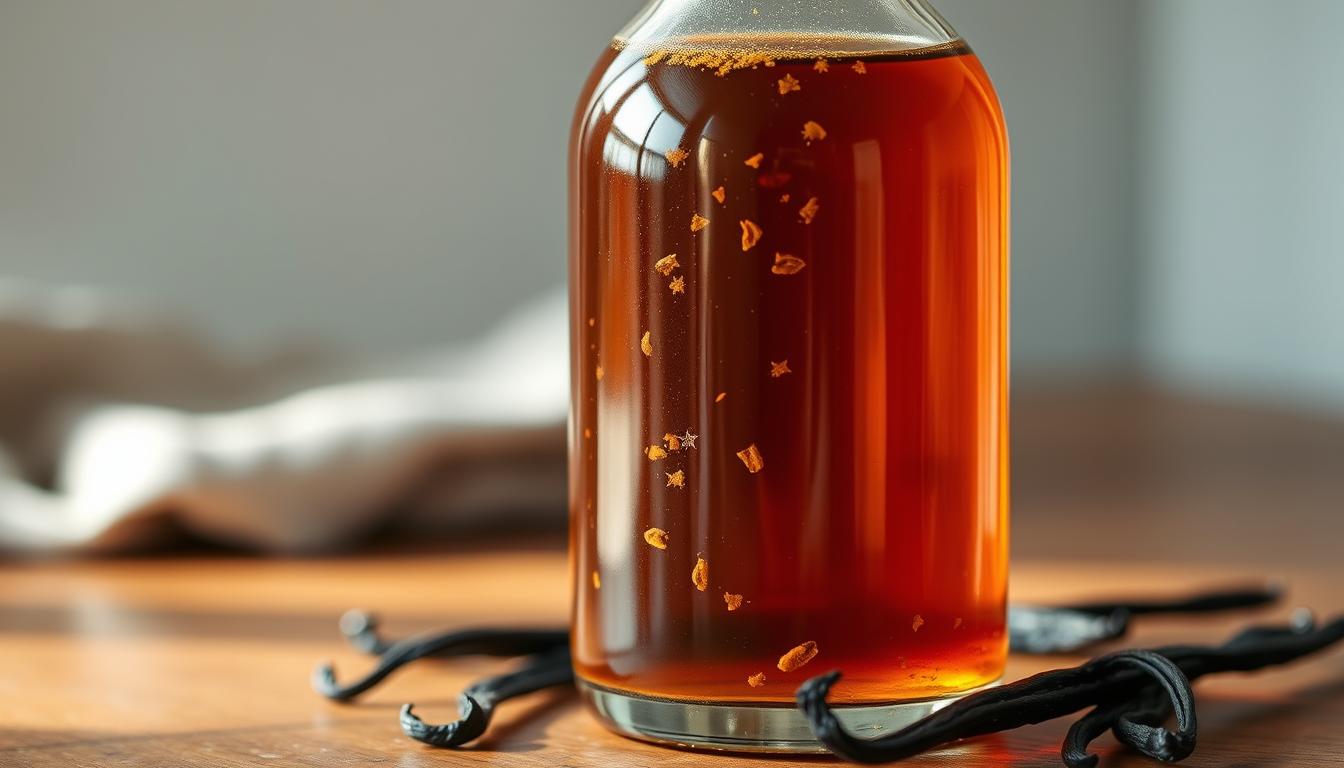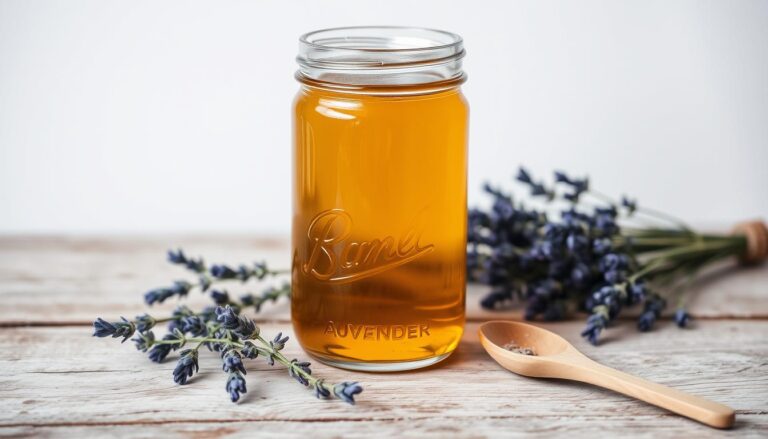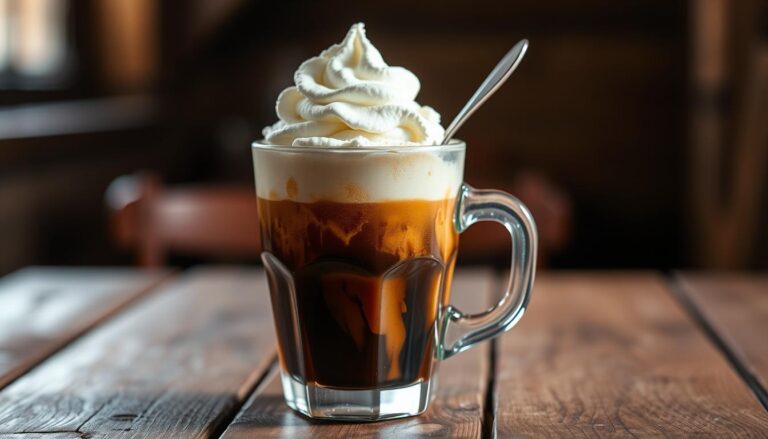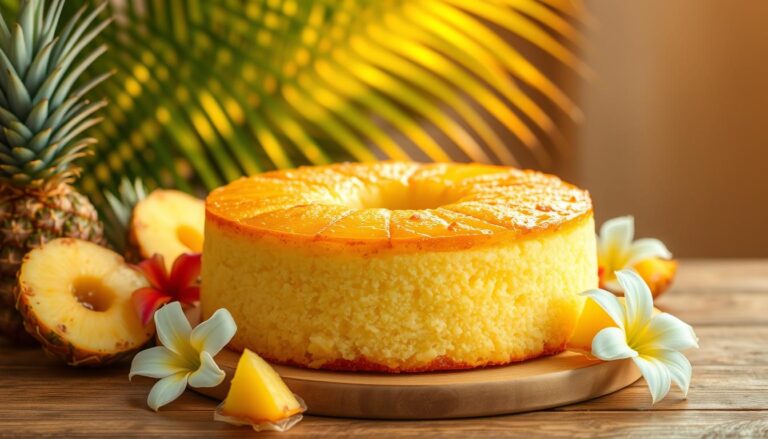Make a Rich Vanilla Bean Syrup
Ever wonder why café-style vanilla lattes taste so luxurious compared to homemade versions? The secret lies in one simple upgrade: vanilla bean syrup.
Unlike store-bought options that use artificial flavors, this syrup features real vanilla bean seeds for an intense, aromatic experience you can craft in minutes.
Traditional vanilla syrup can’t match the depth of flavor from actual bean pods.
Those tiny black specks you see in gourmet drinks aren’t just decorative, they’re packed with natural oils that elevate every sip.
With just three pantry staples, you’ll create a versatile sweetener that transforms coffee, cocktails, and desserts.
Why settle for bland imitations when your kitchen can become a mini coffeehouse?
This guide walks you through each step, from selecting quality ingredients to storing your creation.
You’ll save money, avoid preservatives, and impress guests with drinks that look and taste professional.
So, let’s get it on!
Key Takeaways
- Real vanilla beans provide deeper flavor than artificial extracts.
- Visible bean specks indicate quality and enhance visual appeal.
- Requires only sugar, water, and whole vanilla pods.
- Homemade versions cost less than premium store brands.
- Ideal for recreating café-style drinks at home.
- Lasts up to one month when stored properly.
Recipe for a Rich Vanilla Bean Syrup
This Vanilla Bean Syrup is perfect for floats, milkshakes, coffee, or desserts.
Yield: ~1 ½ cups (about 355 ml)
Ingredients
- 1 cup (200 g) granulated sugar
- 1 cup (240 ml) water
- 2 whole vanilla beans (pods), plump and fresh
Instructions
- Prepare the vanilla beans
- Place the vanilla beans on a clean cutting board.
- Using a sharp paring knife, carefully split each bean lengthwise.
- Scrape out the seeds (caviar) with the back of the knife and set aside.
- Keep both the seeds and pods for the syrup.
- Combine sugar and water
- In a medium saucepan, add 1 cup (200 g) sugar and 1 cup (240 ml) water.
- Stir gently to combine before heating.
- Infuse the vanilla
- Add the scraped vanilla seeds and the empty pods to the saucepan.
- Place over medium heat and bring to a gentle simmer, stirring occasionally until the sugar is completely dissolved.
- Simmer for flavor
- Once dissolved, reduce heat to low and simmer for 5 minutes, allowing the vanilla to fully infuse into the syrup.
- Do not boil vigorously to prevent excessive evaporation.
- Cool and store
- Remove from heat and let the syrup cool to room temperature with the vanilla pods still in the liquid for maximum flavor.
- Once cooled, remove pods (or leave one in the bottle for continued infusion).
- Transfer to a clean, airtight glass bottle or jar.
- Storage
- Store in the refrigerator for up to 4 weeks.
- Shake gently before each use if any vanilla seeds settle at the bottom.
💡 Pro tip: For a stronger vanilla flavor, use 3 pods instead of 2 and let the syrup infuse overnight in the refrigerator before using.
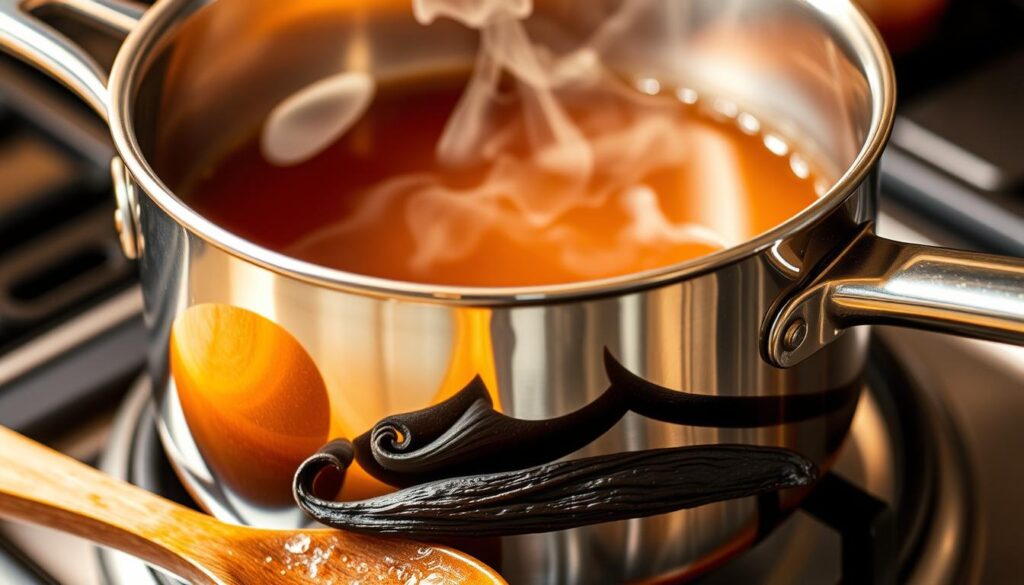
Kitchen Tools
What separates a basic sweetener from a barista-quality addition?
It starts with the right kitchen helpers.
Let’s unpack what you’ll need to craft this liquid gold.
Must-Have Equipment
A medium saucepan ensures even heat distribution during simmering. Use a sharp paring knife to split beans cleanly without crushing them.
A whisk helps dissolve sugar completely.
Avoid substitutes like vanilla paste, whole pods create those signature specks that scream “crafted, not bought.”
Quality matters here. Wrinkled or dry beans lack the oils needed for rich flavor.
If unavailable, use 1 tablespoon pure extract per bean, but expect milder results.
Shop this Recipe
|
Medium-size saucepan | |
|
Cutting Board | |
|
Paring knife | |
|
Glass Syrup Bottle |
Note: Soda Lovers Unite (SLU) partners up with reputable brands to promote useful products. Some or all of the links above may be affiliate links that generate a small revenue for SLU when you buy through them. Thank you for supporting our efforts.
Tips for a Smooth and Sweet Finish
Mastering the texture of your homemade sweetener comes down to one crucial factor: temperature management.
Perfecting this balance ensures a silky consistency without compromising the delicate vanilla notes.
Start by stirring constantly as your mixture heats.
This prevents sugar crystals from forming at the bottom while helping granules dissolve evenly.
Look for tiny bubbles along the pan’s edges – your cue to lower the heat to a gentle simmer.
Heat Control Techniques
Avoid rapid boiling, which evaporates too much liquid and creates overly thick results.
The ideal stage occurs when the liquid turns completely clear with no visible sugar grains.
Use a clean spoon to check. If it feels smooth, you’ve nailed the dissolution process.
Don’t panic if the syrup seems watery initially. As it cools, the liquid naturally thickens into that signature sticky texture.
For consistent outcomes, remove the pan from heat immediately after achieving clarity.
Struggling with crystallization? Return the mixture to low heat and add a teaspoon of hot water.
Stir gently until any graininess disappears.
Remember: patience yields that barista-approved finish for your coffee creations.
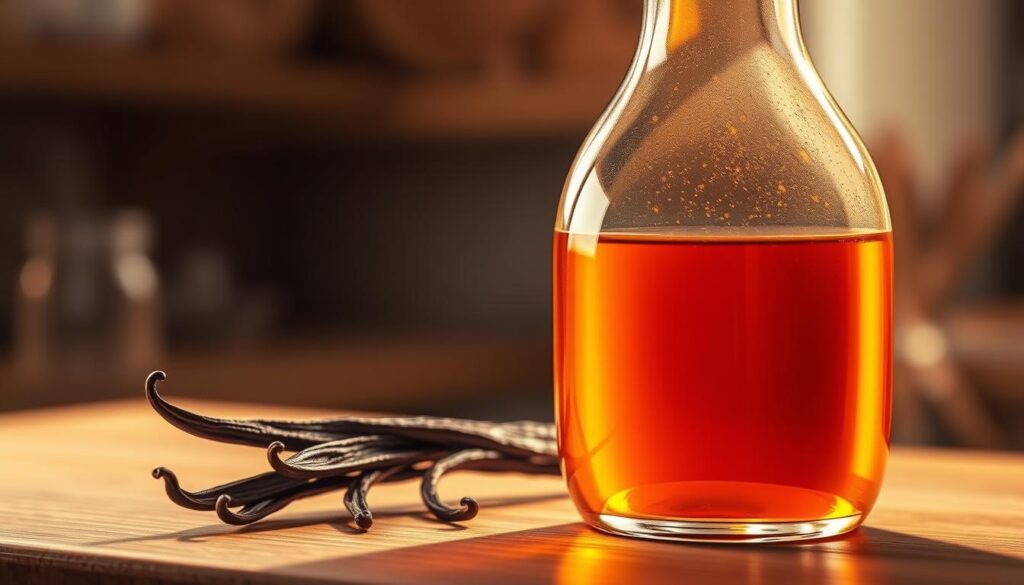
Creative Ideas to Use Your Vanilla Syrup
Your homemade syrup isn’t just for sweetening, it’s a flavor revolution waiting to happen.
From morning pick-me-ups to decadent desserts, this versatile ingredient adds gourmet flair to everyday creations.
Let’s explore unexpected ways to make your kitchen creations shine.
Enhancing Coffee Beverages
Transform your daily brew into something extraordinary.
Stir 1-2 tablespoons into espresso before adding steamed milk for lattes that rival café prices.
The syrup dissolves instantly in hot or iced coffee, creating balanced sweetness without gritty residue.
Cold brew lovers can mix it directly into chilled concentrate. Try layering it with cream over ice for a quick affogato-inspired treat.
Even simple drip coffee becomes special when sweetened with those fragrant vanilla specks.
Innovative Dessert Twists
Drizzle the syrup over sliced strawberries or vanilla ice cream for an instant upgrade.
Mix it into whipped cream for cake fillings, or brush it onto warm pound cake before frosting.
The liquid gold seeps into layers, adding moisture and depth.
For breakfast treats, swirl it into oatmeal or Greek yogurt. Blend with frozen bananas for creamy smoothies, or spike sparkling water for a fancy soda.
Your bottle will empty faster than you expect, in the best way possible.
Storing and Preserving Your Homemade Syrup
Preserving your syrup’s rich flavor requires smart storage solutions.
Follow these guidelines to keep it fresh and safe while maintaining its signature aroma.
Fridge Storage Tips
Always use an airtight container for refrigeration.
Glass jars with tight lids or food-grade plastic containers work best.
Your syrup stays fresh in the fridge for 7-14 days.
| Method | Duration | Container | Notes |
|---|---|---|---|
| Fridge | 1-2 weeks | Airtight glass/plastic | Check for mold weekly |
| Freezer | 6 months | Plastic freezer bags | Remove pods first |
| Room Temp | 1-2 days | Not recommended | Risk of crystallization |
Freezer Storage Guidelines
For long-term storage, freeze portions in ice cube trays. Transfer frozen cubes to a sealed plastic bag once solid. Remove vanilla pods before freezing to prevent bitterness.
Room temperature storage works only for immediate use. Sugar crystallization begins within hours, creating gritty textures.
Always refrigerate after opening.
Watch for cloudy appearance or unusual odors as these signal spoilage.
Label containers with preparation dates to track freshness. Your careful storage ensures every drizzle tastes as vibrant as day one.
Variations Using Vanilla Bean Paste and Extract
Not all kitchens stock whole vanilla pods and that’s okay.
You’ve got options. Whether you prioritize budget, convenience, or visual flair, these alternatives let you craft quality sweeteners without compromise.
Vanilla bean paste shines as the closest substitute to whole pods. Its thick consistency contains real seed specks and concentrated flavor.
Use 1 tablespoon per bean in your recipe. It’s perfect for drizzling over desserts where those dark flecks add elegance.
Pure vanilla extract works well for budget-conscious creators.
Add 1-2 teaspoons after cooling your syrup to preserve its delicate aroma.
While it won’t create those Instagram-worthy specks, it delivers familiar warmth to drinks and baked goods.
| Feature | Vanilla Bean | Paste | Extract |
|---|---|---|---|
| Flavor Intensity | Strongest | Rich | Mild |
| Visual Specks | Yes | Yes | No |
| Cost per Use | $$$ | $$ | $ |
| Best For | Gifting | Desserts | Daily Use |
Choose paste when serving guests, it mimics premium results at half the cost.
Reserve extract for everyday lattes where appearance matters less. Both options keep your creations flavorful, letting you adapt to any situation.
Remember: extracts vary in strength. Always taste-test before adding more.
Your syrup should enhance drinks, not overpower them. With these swaps, you’ll never run out of ways to enjoy that signature sweetness.
Troubleshooting Common Recipe Issues
Even the most carefully crafted sweeteners can sometimes develop unexpected quirks.
Sugar’s natural tendency to crystallize often causes texture issues, but simple fixes restore smoothness quickly.
Let’s tackle the most frequent challenges and their solutions.
Addressing Crystallization Problems
Grainy syrup usually forms when sugar water cools too rapidly or contains impurities.
If you spot crystals, return the mixture to low heat. Add a teaspoon of hot water and stir gently until dissolved.
Always use clean utensils to prevent introducing particles that trigger crystallization.
Prevent future issues by allowing syrup to cool gradually at room temperature.
Avoid stirring once removed from heat since agitation encourages sugar molecules to bond.
The vanilla bean pod adds flavor without affecting texture, so leave it in during storage.
For stubborn cases, strain through a fine mesh sieve. Store your creation in airtight containers, and never refrigerate until fully cooled.
With these adjustments, your simple syrup stays silky for lattes, cocktails, or drizzling over desserts.
FAQ
Can I substitute vanilla extract for fresh beans?
Yes! Use 1 teaspoon of pure extract per bean. Add it after cooling the sugar water to preserve its flavor.
How long does homemade syrup stay fresh?
Store it in an airtight container in the fridge for up to 1 month. For longer storage, freeze portions for 3–4 months.
Why did my syrup crystallize?
Overheating sugar can cause this. Gently reheat the mixture on low and stir until dissolved. Avoid boiling.
Can I use this in cold brew or iced lattes?
Absolutely! It blends smoothly into chilled drinks. Adjust sweetness by starting with 1–2 teaspoons per serving.
Is vanilla bean paste a good alternative?
Paste works well for intense flavor. Use half the amount compared to whole beans, as it’s concentrated.
Does the type of sugar affect the taste?
Granulated white sugar keeps the flavor clean, but coconut or brown sugar adds caramel notes. Experiment!
Can I infuse other spices into the syrup?
Try adding cinnamon sticks or cardamom pods while simmering. Strain them out before bottling for layered flavors.
How do I prevent mold growth in stored syrup?
Always use sterilized containers and let the syrup cool to room temperature before sealing. Keep refrigerated.
